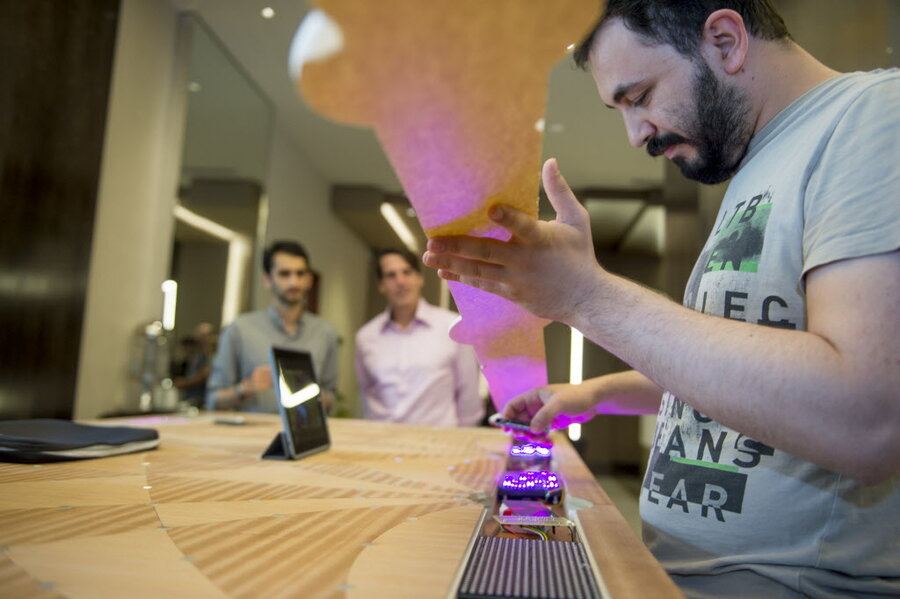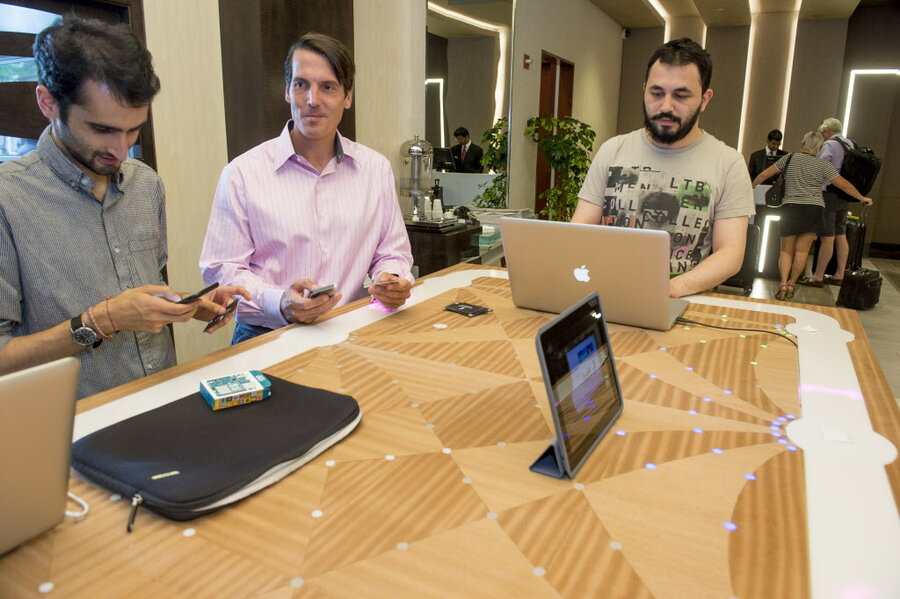Six Degrees app aims at 'hotel lobby of the future'
Loading...
| Cambridge, Mass.
In the lobby of the Boston Marriott Cambridge hotel, a few people stand around a tall, wooden table. One man places a phone on the table. Suddenly, a series of small circles around the phone begin to glow bright neon green, lighting up as if he just had won a carnival game. Across the table, another man’s phone has also caused the circles to turn green. The two men laugh. Identical colors mean they have something in common.
These men are researchers from the Massachusetts Institute of Technology's Mobile Experience Lab. They are working on a prototype application called Six Degrees, the result of collaboration between their lab and Marriott Hotels. The task? To create the “hotel lobby of the future.”
Two years ago, Marriott approached the MIT lab with the question of how to turn a hotel lobby into something that could reflect the personal technologies people use all the time. The hotel chain saw the impending need to brand themselves for a younger generation.
“We determined that in about seven, eight years about half the US working population would be [Generation] Y,” says Paul Cahill, senior vice president of global brand management at Marriott Hotels, who spearheaded the project between Marriott and MIT. “The way people are working and living in this younger generation is more global, more digital, more technological."
“Brands that are super relevant to this younger generation are the ones that are really going to win,” he adds.
Lab researchers began collecting data and observing hotel lobbies, noting the ways people use them and thinking up ways the standard experience could change.
They sought to bring people together, using the social networking site LinkedIn as a common thread to connect hotel guests.
“We saw our lobbies as really great living rooms with little functionality,” says Mr. Cahill. Looking around the hotel lobby, he points to people reading on tablets, working on laptops, texting on phones. “This is a way to enable the social behavior that’s already existing … we want to create a real-time social network in our great room lobbies.”
The MIT researchers, led by director Federico Casalegno, eventually turned their research and concepts into an app called Six Degrees. It aims to make the lobby experience more interactive and more social. It also aims to turn standard hotel furniture into a means of bridging barriers. Guests who might never otherwise speak to each other can break the ice – using technology like the LED table with colored circles.
“We are people-centric,” Mr. Caselegno says of the thought process behind each component of the app. “We want to design technologies around people, not people around technologies.”
Six Degrees consists of three main parts:
First, a guest can download the app and sign in using his or her LinkedIn account, letting them find other guests with similar backgrounds. Second, an interactive digital screen in the hotel lobby displays people’s interests, but tries to respect individual privacy. Third, people can use the furniture in the lobby to interact with their physical surroundings. “It's the 'Internet of Things,' ” says Caselegno, using an expression that describes the interaction between the Internet and the physical world.
While the app has yet to be finalized, guests will have a way, should they choose, to use data stored online to start conversations, perhaps find someone to grab a drink with from their alma matter.
“Hotel lobbies in the past 10 years were just transit areas,” says Matthew Von Ertfelda, head of insight, strategy, and innovation at Marriott International. “There was this need to connect people in a unique way beyond just food and drink.”
The original intent was to have guests connect using Facebook profiles. But that was deemed “too personal” by the researchers. Instead, they took more of a professional-networking angle.
“We're mainly targeting business people,” says Amar Boghani, lead researcher on Six Degrees.
For now, Marriott will keep testing the app in Boston with plans to begin rolling it out to other Marriott locations around the country, if tests are successful, says Cahill.
As hotel guests look at the table sporadically turning different colors – sometimes pink, sometimes blue – Mr. Boghani stands at the table, typing code on his laptop. He is fixing a bug in the system. The table still has a few glitches, but Boghani doesn’t seem worried. Besides, they’re still in the experimental phase, testing out what works. He says a table might not even be the way guests wind up interacting with the physical space of the lobby. It could be something else entirely.
When asked to give an example, he smiles, glancing around the lobby. His eyes land on the hotel bar.
“Maybe interactive bar coasters,” he says with a laugh.







